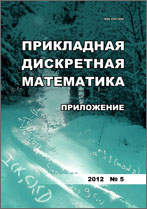|
Theoretical Foundations of Applied Discrete Mathematics
On the anisometric index of a transformation
B. A. Pogorelova, M. A. Pudovkinab
a Academy of Cryptography of Russian Federation, Moscow
b Bauman Moscow State Technical University, Moscow
Abstract:
Many papers deal with finding distances between a transformation and an affine or imprimitive group. In cryptography, these results are often connected with investigations of linear and homomorphic models of block ciphers. Besides, to provide adequate resistance of block ciphers to generalizations of linear and homomorphic attacks, good cryptographic transformations must diffuse the structures associated with the affine and imprimitive groups. Some structures of block ciphers can be linked up with an isometry group of a discrete metric space, but in cryptography, such structures are seldom considered.
In this paper, for a transformation $g\colon V_n(2)\to V_n(2)$ and a partition $\mathbf W$ of the set $(V_n(2))^2$ of the metric space $(\mu,V_n(2))$, we introduce a measure that characterizes the diffusion degree of $\mathbf W$ in relation to $g$. The measure is called the anisometric index of the transformation $g$. We get upper bounds of the anisometric index for some classes of transformations. Further, we show that the anisometric index can be expressed in terms of elements of the difference distribution table. We also get relations between anisometric indexes of affine-equivalent transformations. In addition, we investigate links between two classes of permutations. The first class consists of all permutations that have the largest Hamming distance from imprimitive groups $S_{2^{n - 1}}\wr S_2$, $S_2\wr S_{2^{n - 1}}$. The second class consists of all permutations that have the largest anisometric index. In particular, we show that, for some metrics, these classes are the same ones.
Keywords:
Hamming distance, isometry group, difference distribution table, imprimitive group.
Citation:
B. A. Pogorelov, M. A. Pudovkina, “On the anisometric index of a transformation”, Prikl. Diskr. Mat. Suppl., 2017, no. 10, 25–27
Linking options:
https://www.mathnet.ru/eng/pdma355 https://www.mathnet.ru/eng/pdma/y2017/i10/p25
|

| Statistics & downloads: |
| Abstract page: | 179 | | Full-text PDF : | 46 | | References: | 42 |
|




 Contact us:
Contact us: Terms of Use
Terms of Use
 Registration to the website
Registration to the website Logotypes
Logotypes








 Citation in format
Citation in format 